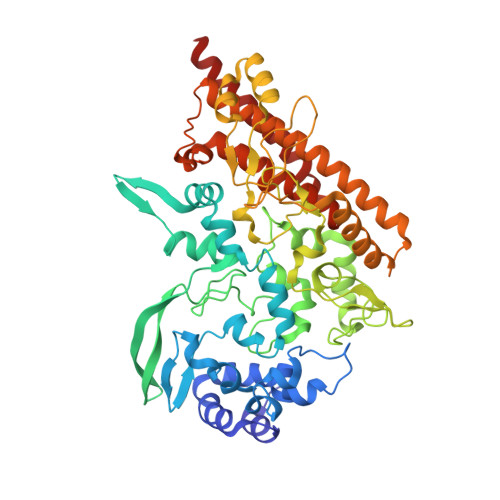In meso crystal structure of a novel membrane-associated octaheme cytochrome c from the Crenarchaeon Ignicoccus hospitalis.
Parey, K., Fielding, A.J., Sorgel, M., Rachel, R., Huber, H., Ziegler, C., Rajendran, C.(2016) FEBS J 283: 3807-3820
- PubMed: 27586496
- DOI: https://doi.org/10.1111/febs.13870
- Primary Citation of Related Structures:
4QO5 - PubMed Abstract:
The Crenarchaeon Ignicoccus hospitalis lives in symbiosis with Nanoarchaeum equitans providing essential cell components and nutrients to its symbiont. Ignicoccus hospitalis shows an intriguing morphology that points toward an evolutionary role in driving compartmentalization. Therefore, the bioenergetics of this archaeal host-symbiont system remains a pressing question. To date, the only electron acceptor described for I. hospitalis is elemental sulfur, but the organism comprises genes that encode for enzymes involved in nitrogen metabolism, e.g., one nitrate reductase and two octaheme cytochrome c, Igni_0955 (IhOCC) and Igni_1359. Herein, we detail functional and structural studies of the highly abundant IhOCC, including an X-ray crystal structure at 1.7 Å resolution, the first three-dimensional structure of an archaeal OCC. The trimeric IhOCC is membrane associated and exhibits significant structural and functional differences to previously characterized homologs within the hydroxylamine oxidoreductases (HAOs) and octaheme cytochrome c nitrite reductases (ONRs). The positions and spatial arrangement of the eight hemes are highly conserved, but the axial ligands of the individual hemes 3, 6 and 7 and the protein environment of the active site show significant differences. Most notably, the active site heme 4 lacks porphyrin-tyrosine cross-links present in the HAO family. We show that IhOCC efficiently reduces nitrite and hydroxylamine, with possible relevance to detoxification or energy conservation.
Organizational Affiliation:
Department of Structural Biology, Max Planck Institute of Biophysics, Frankfurt am Main, Germany. kristian.parey@biophys.mpg.de.

















